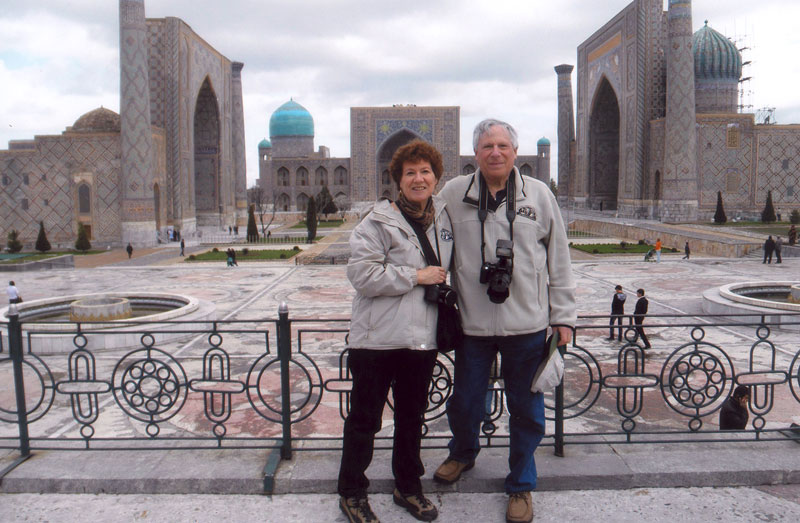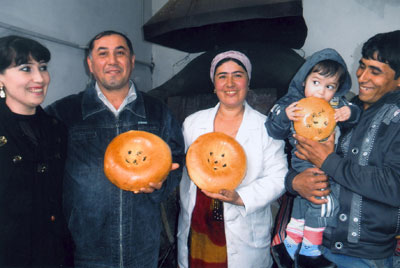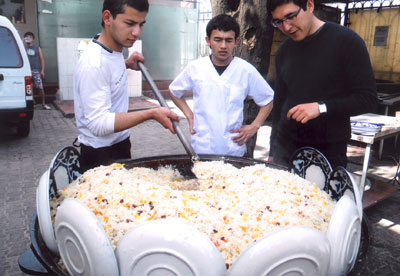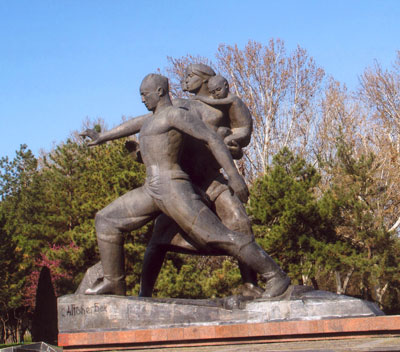Mausoleums, madrassahs, minarets and markets — an enlightening visit to Uzbekistan
This article appears on page 44 of the February 2014 issue.
Arlene Lichtenstein; Commack, NY
My husband, Alan, longed to travel the Silk Road and visit the five ’Stans. He loves exotic destinations that few tourists have yet discovered. I, on the other hand, resisted the lure of what I believed were few wondrous sights (not to mention the deterrent of Eastern-style toilets).
When a week’s preextension trip to one of the ’Stans, Uzbekistan ($2,595), was added to an eastern Turkey trip we had booked with Overseas Adventure Travel (Cambridge, MA; 800/955-1925), I relented, thinking a week was certainly doable for me.
Uzbekistan was a revelation — interesting sights, friendly people, fascinating history and lovely handicrafts. I am so glad we went!
First impressions
We departed on our journey in April 2013. For our overnight flight to Istanbul on Turkish Airlines, we elected to pay an extra $250 per person above the round-trip economy airfare included in our trip cost for seats in Comfort Class, and it was worth every penny. We then flew overnight to Tashkent.
Queuing up patiently does not seem to be part of the Uzbekistani culture, but, once we were on our way, we found Uzbeks to be friendly, polite and extremely interested in American visitors. In every city, people wanted to talk to us, practice their English and have their pictures taken with us.
We were lucky to have an extremely knowledgeable, personable guide who had an excellent command of English. Bekhruz Kurbanov led us through Uzbekistan explaining the country’s history, telling stories that brought ancient sites alive and facilitating our interaction with the local population. I would heartily recommend him to anyone wishing to experience Uzbekistan.
Tashkent
We visited three cities, each more interesting than the preceding one. Tashkent was the first.
We stayed at the Tashkent Palace Hotel, an older Soviet-style hotel with large rooms and a lovely restaurant offering an excellent breakfast buffet.
Our first day was filled with interesting sights. The Monument to Courage, commemorating the 1966 earthquake that destroyed parts of Tashkent, depicts a mother protecting her child and an Uzbek man protecting them both. All the figures are strong and bold.
We also saw a statue of Amir Timur (Tamerlane) on horseback. Timur is the national hero of Uzbekistan, and he was both a conqueror and an emperor who lived from 1336 to 1405. We would discover more about him in Samarkand, where he is buried.
Other noteworthy sites in Tashkent included the covered Chorsu Bazaar, with stall after stall of produce, spices, dried fruits and a variety of other goods, and the Museum of Applied Arts, housing ceramic and textile displays and traditional handicrafts.
Under Soviet domination, handicrafts like traditional fabrics, lacquerware, metalwork, ceramics, wood crafts and embroidery all were banned, and conformity was encouraged. Now there are many artisans practicing these crafts once again.
A beautiful 19th-century madrassah (school) housed many of these craftsmen, and we were able to browse the stalls, watch them at work and purchase some of the wonderful pieces.
We rode on the subway to Tashkent’s Independence Square. The subway stations all are spotlessly clean, cavernous and beautifully decorated with mosaics celebrating different events of Uzbek life. No photos were allowed, and there was a visible police presence.
Metallic storks in flight greet visitors to the square. Storks represent prosperity, well being and a peaceful lifestyle.
Our guide told us that during the period of Soviet rule, all the storks left Uzbekistan. Although it’s true that the Soviets drained the marshes, eliminating their habitat, people claimed that it was because prosperity and well being were also disappearing. After 1991, we were told, the storks returned.
A poignant memorial, which includes the names of the 400,000 men who fought alongside the Russians during World War II and did not return, can be found in the square as well.
Finally, we stopped for lunch at the Central Asian Plov Center. Plov, the national dish, consists of rice with a variety of vegetables and meat. Ours had raisins, yellow peppers, other vegetables and, if we wished, horse meat. It was very tasty and cost only 6,000 som, or less than $3, for two people.
Although we used som to purchase small items, we discovered that most vendors wanted American dollars.
Samarkand
Samarkand was the next city we visited. The bus ride there took approximately four to five hours. The road was totally pockmarked by potholes and giant puddles.
When the Soviets left in 1991, the roads began to crumble. There is work being done to repair the country’s infrastructure but not on that particular road yet.
City streets were also uneven, with loose or missing paving stones. I found it imperative to always watch where I was walking.
There is a more direct route to Samarkand from Tashkent, but it goes through Tajikistan, and Uzbekistan no longer has a friendly relationship with that country.
Along the way we visited a family-run bread bakery. The 45-year-old grandmother baked 100 rounds of bread a day. She prepared the dough, pounding and shaping it, then baked it in an earthenware oven by placing it on the oven walls. Twenty minutes later, perfectly browned and tasty bread was removed from the oven.
Her husband sold the bread in the market for 2,000-3,000 som ($1-$1.50). On a good day, the family earns $25-$40. Three generations lived and worked together in the home.
Samarkand, an important Silk Road city, was at the crossroads leading to China, India and Persia. We saw many beautiful historical sites.
First was the Gur-e Amir Mausoleum, where Tamerlane is buried at the foot of his spiritual master and near his favorite grandson. Gur-e Amir, with its intricate ornamentation and mosaics, was built for this grandson.
The Shakhi-Zinda Necropolis and the Bibi-Khanum Mosque, with their beautiful blue domes, were impressive. At many of the sites we visited, locals stopped to talk to us. Our guide, of course, interpreted for us and told us to always smile and place our right hand on our chests as a mark of respect or when saying ‘Thank you’ or ‘Good-bye.’
We met three old, white-bearded men, the most respected people in their village, who wished us well and were happy to see Americans. We sang “Happy Birthday” to a child after conversing with his parents and took pictures with groups of teachers, nurses and weaving students, among many, many others, all so interested in American visitors.
Among our final stops that day was the beautiful Ulugh Beg (Ulugbek) Observatory, located just outside of Samarkand. Ulugh Beg, a grandson of Tamerlane, was a sultan and astronomer who wanted to catalog the stars and map the sun, moon and planets.
At last, we were off to the iconic Registan Square, the most familiar sight in Samarkand. Registan was the central square used for executions before three beautiful madrassahs were built there.
The large madrassahs are decorated with azure mosaics, one with fanciful lions adorning the top of the portal. Centuries ago, lectures about astronomy, mathematics and other subjects, both secular and religious, were held there. Today, the two stories of dormitory cells no longer hold students but house artisans’ workshops, some sponsored by the US government. We were able to browse, admire and shop.
Day trip
The next day, our very full itinerary led us to Shakhrisabz. The road there was extremely bumpy and filled with potholes, chasms and abysses. Luckily, our driver, Vadim, skillfully avoided them all.
On the way, scenic views of snow-covered mountains kept us glued to the windows.
Tamerlane’s palace, Ak-Saray, no longer stands, but ruins of its main portal, 40 meters high, are covered with beautiful mosaics, and there is a centrally placed statue of Tamerlane.
On our return to Samarkand, we stopped at a paper factory. As in the centuries-old tradition, a waterwheel pounded mulberry tree bark until it became pulp, which was then soaked, flattened and dried until it became more like silk than paper.
Samarkand was the paper-manufacturing center of the Near and Middle East during the eighth and ninth centuries. The paper was used for judicial documents and for manuscripts of Central Asian classics. The shop now sells the paper with embroidered pictures.
Bukhara
We arrived in Bukhara, a Silk Road city founded in the sixth century BC, the next day. We stayed at the Asia Bukhara Hotel, located very close to the Old City.
Along the road, we stopped at a medieval caravansarai where merchants in the 11th to 16th centuries stopped for the night as they traveled the Silk Road.
We walked through the beautiful Old City admiring Lyab-i Hauz (with its serene pond), 13th-century madrassahs and the three Trading Domes, which mark the crossroads of the city.
A late-ninth-century mausoleum, Ismoil Samoniy, featuring 22 different patterns of intricate brickwork, amazed us. Another remarkable site was the Kalon Mosque and Minaret. The minaret, 45 meters tall, is encircled by glazed blue tiles in intricate designs.
The Ark, a fifth-century fortress built on an artificial hill, was another stop in this unusual city. Prison cells for the emir’s enemies lined the entrance.
Behind the Ark is fearsome Zindon Prison, with its infamous Bug Pit. Four meters deep, covered with an iron grill and accessible only via a long rope, it was reserved for the least-favorite prison inhabitants.
During some free time, Alan and I visited the Old and New synagogues and the Jewish Quarter of Bukhara. Fifty-five families, a total of 300 people, keep these synagogues operating.
Jews arrived in Bukhara as early as the fourth century AD. Stalin sent thousands more at the start of World War II. Ironically, this forced deportation saved their lives.
In 1972 and 1991, mass emigrations to Israel took place, greatly diminishing the Jewish community there.
Looking back
A visit to a puppet maker’s workshop ended our time in Bukhara. We marveled at all we had seen and done during our busy but well-paced week of sightseeing. Yes, Uzbekistan is a developing country and many things are not up to American standards, but the sights, the architecture, the people, the culture, the history, the scenery and the crafts were all so interesting. It was easy to overlook the bumpy roads and non-Western toilets.
I am so glad my husband convinced me to take this journey — a highlight of our travels.




